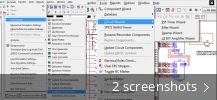

In state 6, those three segments are all high for the first time. As there are no BCD outputs, we must distinguish the state 6 using

It is therefore necessary to shorten its counting cycle.Īt 6 it must reset - go immediately to state 0. When dividing by two, Carry Out pin is always high and never changes its state.Ĭounters at ones of seconds and ones of minutes count from 0 to 9 (base-10), and require no modifications.Ĭircuits at tens of seconds and tens of minutes must count from 0 to 5 (base-6). Note that Carry Out pin (5) of IO2 can't be used as 1Hz output! It only works for divisionīy 6 to 10, since it is high for states 0 to 4 and low for states 5 to 9.

To clock the ones of seconds - pin 1 of IO3 circuit. For load balancing, we will use any two of them to power the dots and third one

These can be used to control the seconds and also to power the flashing dots. 1Hz signal is available at 4 different outputs - the outputs of segments a, d, e, f. Thus, only the digits 0 and 1 alternate with a frequency of 1 Hz. Therefore, when the counter reaches state 2, it almost immediately resets and gets into state 0. Segment g is not activeįor the digits 0 and 1, but it is active (high) for the digit 2. Since it doesn't have any BCD outputs, we connect the reset input to segment g output. Counting cycle 10 is shortened toĢ using reset input (pin 15). The 2Hz signal enters its CLK input (pin 1) through R3, R4, R5. For simplicity it is also 4026, despite it doesn't have any display connected. 2 Hz frequency must be first divided by two in order to get 1Hz for seconds. Increments the next counter during overflow. They also have Carry Out output (pin 5), which Unlike conventional BCD counters, they don't need a decoder from BCD to 7 segments.Īctive level is high (log 1), so we use displays with common cathode. The decade counters 4026 are interesting because they have direct outputs for the 7-segment display. It's made from common and easily available CMOS integrated circuits:Ĭrystal oscillator with a prescaler 4060 and seven decimal counters 4026.Ĥ060 circuit (IO1) divides crystal frequency 32 768 Hz using a 14-stage binary prescaler down to 2 Hz frequency. This simple clock displays time in HH.MM.SS format in 24-hour mode.


 0 kommentar(er)
0 kommentar(er)
